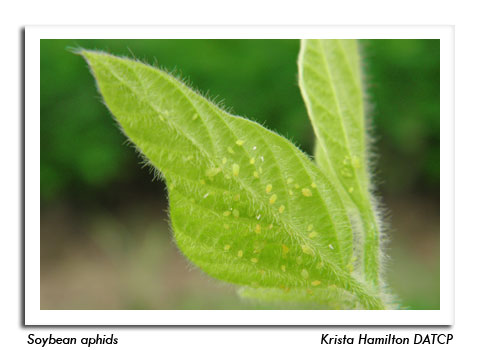
 |
|
|
Looking Ahead
Volume 57 Number 9 Date 06/07/2012 EUROPEAN CORN BORER - The treatment window for first generation larvae has opened near Beloit, La Crosse, Madison, Sullivan and other advanced southern and west-central locations. Close inspection of susceptible corn fields and Bt refuge areas should begin at this time and continue during the next 2-3 weeks. STALK BORER - Minor injury to corn has been observed in southern and central Wisconsin corn fields. Damage thus far is limited to 1-9% of plants in the peripheral rows, but is expected to become increasingly pronounced as more larvae migrate from weed hosts this month. Spot treatment is justified if 10% of plants are damaged and should be made before the larvae bore into stalks. SOYBEAN APHID - The first aphids of the season were detected in Columbia and La Crosse counties on June 4. Densities were very low and ranged from 1-3 per infested plant on no more than 2 per 100 plants. In addition, Dr. David Voegtlin, of the Illinois Natural History Survey reports that a single aphid was captured in the Antigo suction trap during the week May 25, one of the earliest spring collection dates on record for this pest. ROSE CHAFER - This scarab beetle has become more common in the in the past two weeks and light damage is now evident in soybean fields in the central area of the state. Defoliation levels, however, have not exceeded 40% in any early vegetative field checked as of June 5, so treatment is not necessary. VARIEGATED CUTWORM - A report from a McCain Foods Field Representative verifies that larvae are infesting potatoes in Adams County. Damage has not exceeded economic levels and controls for Colorado potato beetles are expected to resolve the problem, but this development emphasizes the importance of continued monitoring of alfalfa, beans, potatoes, tomatoes and other hosts through this month, particularly in the northern areas of the state where populations are highest. GRANULATE CUTWORM - This moth species, which bears a striking resemblance to the western bean cutworm adult, is appearing in the black light traps at Arlington, Coon Valley and Mazomanie. The granulate cutworm is noticeably smaller, about ¾ of the size of the western bean cutworm. The annual flight of western bean cutworm adults is unlikely to begin for another 1-2 weeks. --Krista Hamilton, DATCP Entomologist 





|
|
|